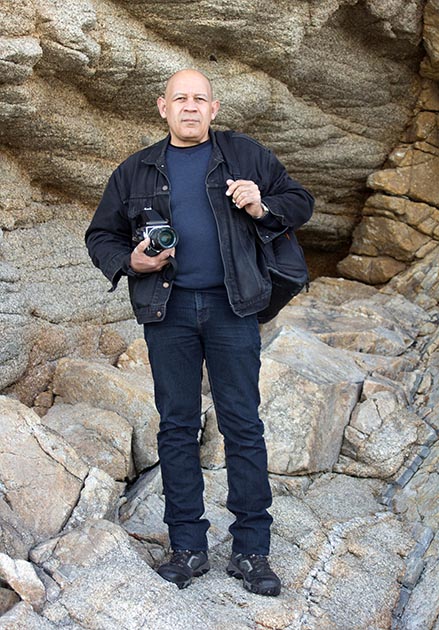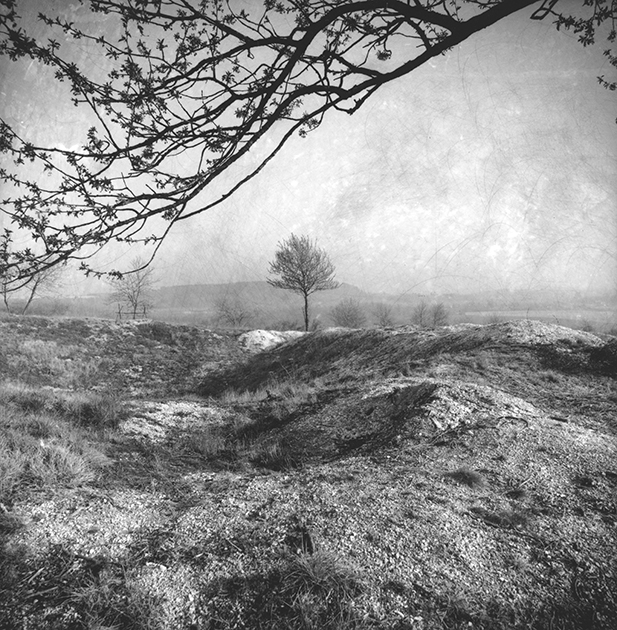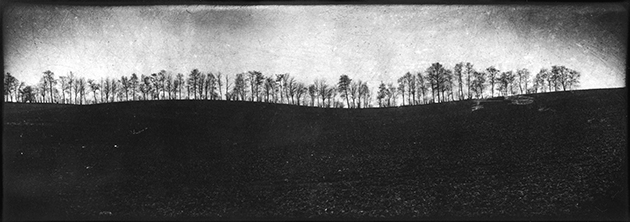An artist’s view: Philippe Bréson

Philippe Bréson is a photographer and visual artist and teaches photography at art schools. Based on seven years of research carried out across the former regions of the front, in 2017 and 2018 he put on a number of exhibitions on the landscapes of the First World War. Cicatrices (‘Scars’) was presented at the Centre André Malraux in Le Bourget and Mnémosis was shown at the French Embassy in the United States and at the international lycées of San Francisco and Washington.

How did you become a photographer?
I am entirely self-taught. When I was ten years old, my uncle showed me how to develop photos. After that, I never stopped. I studied anthropology, then a combination of circumstances led me into journalism, which is how I became a press photographer, before running photographic agencies.
In 2010, I left the press to devote myself to two activities which interest me: teaching and my personal work as a photographer, which had always been there, but which I have now given more energy and meaning.
What themes inspire you as a photographer?
After reportage photography, I became interested in three basic themes: the body, the landscape and still life.
What interested me about landscapes was finding out what was left to explore. I wasn’t looking for beautiful landscapes, nor was I interested in making a documentary. I was after encounters, and sensitive to the idea that time was more important than place. A landscape is an encounter involving a specific moment.
So I wanted to go to places where something had happened, await the specific moment of the encounter and look at the issue of memory: what remains of the fighting when there is nothing left? Does the landscape itself have some value as a preserver of memory? In 2010, I realised that the eyewitnesses of the First World War had all died. That is what stimulated my interest in the First World War landscapes.
How did your encounter with those First World War sites take place?
I had travelled to the Somme because there was severe flooding and I wanted to see what this flooded landscape looked like. When I got there, I said to myself that this was exactly the kind of place I was looking for, where you really feel that something had happened. There were so many cemeteries (to begin with, I thought I was in Normandy!). There was one tiny cemetery in particular, high up on a ridge, with perhaps 40 graves, of British soldiers who had all died on practically the same day. I was struck by how young they were, all 20 year-olds, mere kids. As I was leaving, I saw there was another small ridge opposite, with lots of small trees on top. And I said to myself: “That is one of the last places those British soldiers would have seen in their short lives.” I photographed that ridge because it is one of those landscapes where there is a tension that is bound up with history; in other words, the landscape takes on a value once I know the story behind it. That was the first in a long series of photos, around 150 to 200 in all.

Massiges, Marne. © P. Bréson
How did you go about your project?
My first encounter with the Somme was in autumn 2010, in October/November. It was the land that interested me, so I didn’t want any crops or vegetation. I wasn’t after remnants, cemeteries, monuments, which were put in place after the war, but landscapes. The land sends us signals about the past - like on that little ridge, with its trees evoking the silhouettes of soldiers. I found many others. Then I added my own interpretation: I worked in the morning, quite early, always in winter, in grey weather, at specific times; then I added that layer of history to the photos, by scratching and sandpapering the negatives to give them a particular appearance which, like the landscapes themselves, consisted of scars - hence the exhibition’s title. The project took seven years - seven winters - during which time I went to the battlefields of the North Sea, the Aisne, the Oise, Flanders and Lorraine. I realised that the war had taken place everywhere. These landscapes are really powerful places of remembrance, which have not been preserved. I talked a lot about this to farmers.
I did a huge amount of research to identify all these places, consulting maps and soldiers’ private journals. I also did a lot of work on the memory of the American presence in the French landscape, and of foreign soldiers more generally. I found it fascinating. I became aware of the human history concealed behind every landscape. That is also why I wanted every picture in the exhibition to be accompanied by texts taken from journals and notebooks. The evocative power of text and image makes for a powerful combination.
Have you any other projects linked to contemporary conflicts?
I have long wondered who is really involved in the landscape: farmers, of course, artists (photographers and painters), and soldiers. For the soldier, it is almost more vital than for the others. In soldiers, one also finds this desire to describe the landscape. I think the first treatises on the landscape were military ones: military topography was the first to take an interest in something other than towns or places to grow crops. I find it really interesting to identify this kind of completely improbable link between artists and soldiers.
My father was a soldier, deployed in Algeria. I would like to visit the battlegrounds, but the history of that war is still too recent. I take a very romantic approach to my work, and I don’t want to be burdened by issues that are of no interest to me as an artist.
There are also other, less well-known First World War fronts, which I would like to explore. Then there is the theme of the forest as a refuge, which will be the subject of a forthcoming project.

The area around Albert, in the Somme. © P. Bréson

